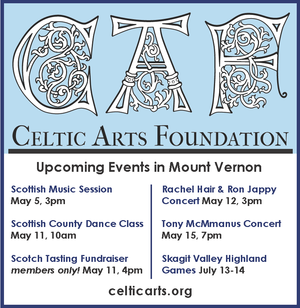A patchwork of culture at the Quilt Museum
May 10, 2017

JAPANESE QUILTS – Now showing at the Pacific Northwest Quilt & Fiber Arts Museum in La Conner are works by artists in Japan. In the foreground is “Twelve Years” by Yuuko Matsumoto depicting her grandson’s handprints. Next is “Momotaro” by Kazuko Yoshiura, depicting a character from a child’s story. – Photo by Maria Matson
Colorful quilts regularly adorn the hallways and numerous rooms of La Conner’s historic Gaches Mansion. Built in 1891, the old Victorian building is far from dusty and forgotten.
It’s home to the Pacific Northwest Quilt & Fiber Arts Museum, where work from artists all over the world is displayed.
The entire second floor of the mansion is currently dedicated to an exhibition by respected Japanese quilter, Miwako Kimura, and her students, titled “For the Love of Children.”
Kimura, who is in her 70’s, began quilting in 1986 and hasn’t stopped since. In Japan, quilting isn’t as popular as in the U.S.
“Compared to American quilt culture, there are only small number of people who know about quilts and quilt culture,” Kimura said in an email. “I have a hope and mission to let them know not only the practical beautiful art works but the enjoyable and meditating hand works.”
She used to work as an interior designer, she said, and became an expert in Japanese design “color, motif pattern, and craftsmanship in the textile industry,” which are deeply based on Kimono culture.
“Her skill is being able to use old Japanese textiles,” Coordinator Ako Shimozato said. “Old kimono fabric and old cotton.”
“She’s one of the sweetest persons, very much respected and easygoing,” Shimozato said. “She’s totally dedicated to what she does.”
Shimozato served on the museum’s board for six years and continues to help to bring Japanese artists and their quilts to La Conner, just like she did 20 years ago with Kimura—the first international exhibit featured at the museum.
Ever since then, Kimura has returned every other year from Japan to display her hand-stitched, masterful quilts. Having Kimura’s art at the museum for the tenth time is a special honor, Amy Green, the museum’s Executive Director, said.
There’s a huge variety of quilt styles and material in Kimura’s exhibition, which features her students works, eight of whom visited the U.S with her this year.
“I am often impressed by their expression of love to their children and grandchildren on their quilts,” Kimura said about her students’ work. Their love of children inspired the theme for this year’s exhibit, which ends on June 25.
In addition to quilts, Kimura’s show displays handmade children’s clothes, cloth diapers and traditional style hats and Kimonos.
Some of their quilts look surprisingly American, Green said, pointing out one that looks like it could have been made for Christmas, complete with green and red themes of Santa and evergreen trees. Keen-eyed observers might recognize a traditional “9-patch” quilting pattern, she said.
“There’s something about quilts that makes people want to wrap themselves up in them. They bring a sense of calm, tradition and family,” Green said.
But don’t expect to see museum visitors walking around in the cozy-looking quilts anytime soon. Many of the type displayed there are called “art quilts,” rather than the familiar, durable “bed quilt,” Green said.
Plus, there’s a no touching rule—sort of. The museum provides gloves to people who want to get hands on, Green said.
“A quilt or fiber art exhibit is very tactile, and that makes people really want to touch it,” Green said, “Especially the quilters who come through. They want to see the back. They want to see how it’s made, how did they quilt the pattern?”
In October, the museum will be celebrating its twentieth anniversary with a “gala” celebration and auction, which will include various donated quilts, including several of Kimura’s award-winning pieces.
Earlier this year, the museum underwent a name change to better represent its range of styles and artists. Originally founded as the “La Conner Quilt Museum,” in 1997, their latest name switch “the Pacific Northwest Quilt & Fiber Arts Museum,” doesn’t mean they aren’t still proud to represent La Conner, Green said, but they wanted to reach a wider population.
“Our name in people’s mind really kind of pigeonholed us,” she said. “We needed our reputation to be more realistically represented.”
At the Pacific Northwest Quilt & Fiber Arts Museum, quilting enthusiasts come together in their own “quilting world” that spans cultures and traditions—and that’s a fabric that factory-produced quilts can never replace.











Reader Comments(0)